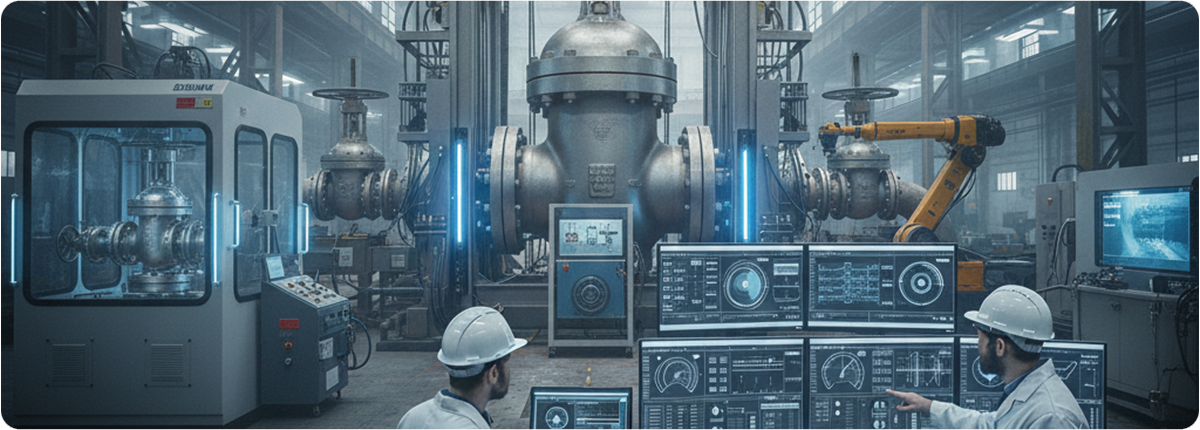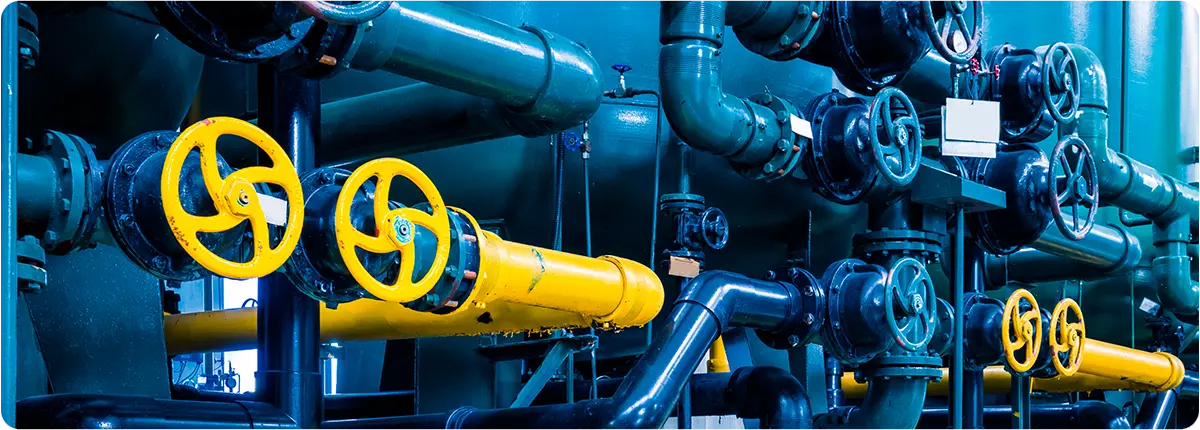In North America, valve requirements are defined by multiple complementary standards that cover design, ratings, leakage acceptance, fire-safety, emissions, and waterworks performance.
- ASME B16.34 — Design, materials, wall thickness, P–T ratings, marking, baseline tests.
- API 598 — General inspection and testing for isolation valves.
- API 6D / ISO 14313 — Pipeline valve integrity (DBB/DIB, cavity relief, gas seat tests, torque).
- MSS SP-61 — Common pressure-testing practice for steel valves.
- FCI/ANSI 70-2 — Control valve leakage Classes II–VI.
- API 607 / API 6FA — Fire tests; ISO 10497 global equivalent.
- API 641 / 622 / 624 — Low-emission standards.
- AWWA Series — Waterworks standards (C509, C515, C504, C507).

ASME B16.34 — THE CONSTRUCTION & RATING SPINE
ASME B16.34 covers metallic valves and defines pressure–temperature ratings, material groups, minimum wall thickness, marking, and baseline pressure tests.
Practical use:
- Select material per chemistry and temperature.
- Confirm P–T rating for worst-case condition.
- Use ASME B16.5/B16.47 for flanges.
Spec line: “Valves shall conform to ASME B16.34 for design, materials, wall thickness, and P–T ratings.”
API 598 — THE EVERYDAY INSPECTION & TEST STANDARD
Defines hydrostatic shell and seat tests, low-pressure gas tests, backseat tests, and operational checks.
Acceptance:
- Soft seats: zero visible leakage.
- Metal seats: limited visible leakage allowed.
- Check valves: specific criteria apply.
Engineer’s tip: shell test hydro, seat test per API 598, add low-pressure air test for soft seats.
API 6D — PIPELINE VALVES
Includes DBB/DIB verification, cavity relief, high-pressure gas seat tests, torque checks, and documentation requirements. Stricter than API 598.
Spec line: “Pipeline valves shall meet API 6D, verify DIB as specified, cavity relief, gas seat tests, torque.”
MSS SP-61 — STEEL VALVES TESTING
Standard pressure-testing practice for steel valves. Commonly used where API 598 is not mandated and often paired with ASME B16.34.
FCI/ANSI 70-2 — CONTROL VALVE SHUTOFF
Defines Classes II–VI for control valve seat leakage. Class IV is typical default; Class V/VI used for demanding services.
Spec line: “Control valve shutoff shall meet FCI 70-2 Class IV unless otherwise specified.”
FIRE-SAFE TESTING
Fire test standards include API 607, API 6FA, and ISO 10497. Valves are exposed to fire while pressurized to measure primary and secondary leakage.
Spec line: “Valves in hydrocarbon service shall be fire-tested per API 607 or API 6FA/ISO 10497.”
LOW EMISSIONS STANDARDS
Low-emission requirements include API 641 for quarter-turn valves, API 622 for packing, and API 624 for rising-stem valves.
Spec line: “Valves in VOC service shall meet API 641 or API 624 with API 622 packing.”
WATERWORKS — AWWA
AWWA standards apply to potable water valves and differ from API/ASME in pressure classes, coatings, torque expectations, and service conditions.
FACTORY ACCEPTANCE TESTS (FATs)
- Hydrostatic shell test ~1.5× rating.
- Directional hydro seat test.
- Low-pressure air seat test (soft seats).
- Backseat test (if provided).
- Operational/torque checks.
- Special tests: fire-safe, FE, cryogenic, vacuum, DBB/DIB.
ACCEPTANCE & DOCUMENTATION
- Soft seats: zero leakage.
- Metal seats: limited leakage per API/ISO.
- MTCs, calibrations, test records, markings, fire-safe/FE certificates.
API VS EN/ISO DIFFERENCES
API focuses on procedural testing and visual acceptance, while EN/ISO uses numeric leakage classes. Projects often blend the two.
Example: “Shell per API 598; Seat per ISO 5208, Rate A.”
EXAMPLE SPECIFICATION LANGUAGE
- Isolation valves: ASME B16.34 design, API 598 tests, ISO 5208 leakage rates.
- Pipeline valves: API 6D, DBB/DIB, cavity relief, gas seat tests.
- Control valves: IEC 60534-4, FCI 70-2 Class IV.
- Fire-safe: API 607/6FA/ISO 10497.
- Low emissions: API 641/624/622.
- Waterworks: AWWA + NSF coatings.
COMMON PITFALLS
- Over-specifying Class VI for control valves.
- Skipping gas seat tests for gas service.
- Confusing DBB vs DIB terminology.
- Not specifying soft-seat air test.
- Mixing AWWA with API without caution.
